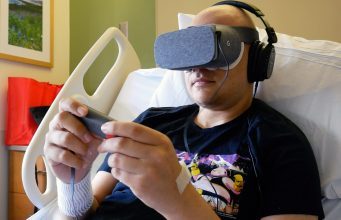
Google’s newly announced Daydream Impact program is a philanthropy project that provides organizations, nonprofits, and advocates for change with resources, tools, and training to create immersive VR content to support their cause. Instead of just creating advertisements, organizations using the program can now immerse users into a situation, with the hope of generating a greater empathetic response in viewers than traditional media.
Google offers the example of the melting of polar ice caps; it’s one thing to read about it or see a video, but it’s thought to be a more meaningful experience to be beside or on top of the glacier as the enormous sheets of ice calve off and crash into the ocean. Of course most people would never get a chance to see something of this magnitude in person, but immersive 360 video through a VR headset could bring people closer to that experience.
The program has already been piloted by several organizations who have created their own videos available on YouTube in 360 view:
- The Rising Seas Project documents the normal high tide and extremely high tides during the winter and summer solstices (known as King Tides) in Los Angeles, CA, to show changes in coastline environments, and impacts of rising tides.
- Harmony Labs created several anti-bullying pieces to pilot in school’s, Stand-up is presented here
- Springbok Cares is integrating VR headset use into hospital environments as entertainment and escape for patients receiving cancer treatments. In a short video provided by Google from Springbok Cares, patients responded very positively after interacting with headsets during their cancer treatments.
- Eastern Congo Initiative displays the struggles of living in the Congo and the resilience of its people.
Google says that Daydream Impact is comprised of two main components:
- A free online training course called Coursera, available online to teach organizations how to create VR content. The course starts off by outlining basic hardware requirements and pre-production checklists. It provides tips, suggestions, and best practice recommendations from other content creators on how to obtain the best and most impactful 360 degree footage. Post-production work required to create the video as well as guidance on how to publish and promote videos are also covered in the training.
- Google is launching a loaner program to provide qualified applicants/projects access to equipment to produce and showcase their creations in VR. The equipment list includes: a Jump Camera, an Expeditions kit (including, a tablet [for a teacher], mobile phones, VR viewers, a router, chargers, and a storage case), a Google Daydream View headset, and a Daydream-ready phone.
Applications to the Daydream Impact program can be completed by organization leaders. Accepted applicants will have six months to capture and refine their work, and showcase to their stakeholders.
Dane Erickson, the Managing Director from Eastern Congo Initiative, expressed that as a non-profit they would not be able to afford the equipment necessary to create VR content without the help of the program. He has also expressed interest in bringing their content into a classroom setting to connect with and educate children on the work that they do in Congo.
Harmony Labs Impact Design Director, Mary Joyce, also discussed applying their content to school settings to hopefully facilitate positive behavior change in children, and encourage children to stand-up against school-based bullying.
Google stated that upcoming projects and case studies will be presented from World Wildlife Fund & Condition One, UNAIDS, the International Committee of the Red Cross, Starlight Children’s Foundation, Protect our Winters, and Novo Media in 2018.
The post Google’s Daydream Impact Project Aims to Bolster Philanthropic Efforts With VR appeared first on Road to VR.
Ream more: https://www.roadtovr.com/google-daydream-impact-project-bolster-philanthropic-efforts-with-vr/
No comments:
Post a Comment